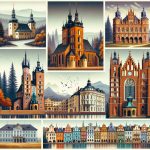
In Canada, which is home to many different cultural backgrounds, Polish culture adds an interesting aspect to this mix. There are plenty of Polish festivals, delicious food, historic places, and art to explore. These activities not only let us enjoy Polish traditions but also help us connect with various cultures.
By diving into Polish music, dance, and community gatherings, we get to learn about their resilience, traditions, and how they share their culture with others. Let’s take a closer look at what Polish culture has to offer in Canada.
Discovering Polish Festivals
Exploring Polish festivals in Canada reveals the vibrant and diverse culture of Polish Canadians. These events, from Toronto’s large Roncesvalles Polish Festival to smaller gatherings in various communities, highlight Polish traditions. Each festival, unique in its own right, tells a story of migration, adaptation, and cultural continuity. Attendees can experience traditional Polish music, dance, and art, making these festivals a way for both Polish Canadians and others to learn about and appreciate Polish contributions to Canada’s cultural landscape.
For example, at the Roncesvalles Polish Festival, you might find yourself swept away by lively polka music or captivated by a traditional dance performance. These festivals also offer a chance to taste authentic Polish cuisine, from pierogi to kielbasa, allowing everyone to explore Polish flavors. Beyond food and entertainment, these festivals often include exhibits on Polish history and workshops on arts and crafts, providing a deeper understanding of Polish culture.
These gatherings are more than just celebrations; they are opportunities for cultural exchange and community building. By participating, people of all backgrounds can connect with the Polish community, learn something new, and enjoy a fun and welcoming atmosphere. Whether you’re of Polish descent or simply curious about different cultures, attending a Polish festival in Canada can be a rewarding experience.
Savoring Traditional Cuisine
Exploring Polish culture in Canada, we find that traditional cuisine plays a key role in connecting people to their heritage. Polish food, with its long history, offers a glimpse into the nation’s past and its community life. For example, pierogi are dumplings that can be filled with various ingredients, such as cheese and potatoes or even fruits. This dish represents the balance between simple and sophisticated cooking techniques that Polish cuisine is known for.
Another staple is bigos, a rich stew made of sauerkraut and meat. This dish highlights the Polish skill in blending different flavors to create a cohesive and delicious meal. In Canadian Polish communities, dishes like pierogi and bigos are not just food; they are a means of sharing stories, connecting with others, and keeping cultural traditions alive in a diverse country like Canada.
When we talk about these dishes, we’re not just discussing food but also the art of Polish cooking and its impact on cultural identity. These meals serve as a bridge between generations, enabling the transfer of traditions and the strengthening of bonds within the community.
Exploring Historic Sites
Poland’s history in Canada is clearly seen through its historic sites, which connect us to the Polish community’s lasting impact and cultural contributions in this diverse country. These landmarks tell the story of Polish immigrants, highlighting their resilience and crucial role in shaping Canadian society. For example, St. Mary’s Polish Church in Nova Scotia is an architectural wonder that shows the early Polish settlers’ dedication and sense of community. Meanwhile, Roncesvalles Village in Toronto is a vibrant area where Polish language, traditions, and festivals are alive and well, offering a rich cultural experience.
These places do more than just keep history and culture alive. They also help maintain a sense of identity and continuity among the Polish people in Canada. Visiting these sites, one can get a real feel for the Polish community’s contributions over the years. Whether it’s the stunning architecture of St. Mary’s Church or the lively celebrations in Roncesvalles Village, these landmarks offer a direct connection to Poland’s heritage in Canada.
In a nutshell, Poland’s historic sites in Canada are essential for understanding the country’s multicultural landscape. They provide a unique insight into the Polish community’s journey and achievements. By exploring these sites, we can appreciate the rich tapestry of cultures that make up Canada.
Enjoying Music and Dance
Polish culture in Canada is not just about historic sites; it also comes alive with music and dance, bringing people together and celebrating their shared heritage. Traditional Polish music, a mix of old folk melodies and modern rhythms, is popular at various Canadian multicultural events. This music, with its unique blend, connects the Polish community to its roots while inviting others to explore its rich cultural heritage.
Dance plays a significant role too, especially the polonaise and mazurka. These dances, known for their grace and energy, are more than just performances. They are a way for the Polish community in Canada to keep their culture alive. When these dances are performed, whether at festivals or private gatherings, they do more than entertain. They tell a story of Poland’s history and traditions through their steps, costumes, and music.
Imagine attending a Polish festival in Canada. You’d see dancers in vibrant costumes moving to the rhythm of the music, their feet performing complex steps. This scene not only showcases Poland’s cultural diversity but also invites everyone, Polish or not, to learn about and appreciate this rich heritage.
Engaging With Community Events
Community events play a vital role for the Polish community in Canada, creating a strong sense of belonging and cultural identity. For example, the Dożynki harvest festival showcases Poland’s rich traditions through vibrant celebrations, while Polish Independence Day offers a moment to honor the nation’s history with solemn respect. These events are not just gatherings; they’re a chance for people to connect with their roots and share their heritage with the next generation.
By taking part in these celebrations, individuals actively contribute to keeping their traditions alive. It’s about more than just having fun; it’s about teaching young people the value of their culture through direct experience. Whether it’s through sharing traditional Polish recipes, singing folk songs, or recounting historical tales, each aspect of these events ties the community closer together.
These celebrations also serve as a bridge between Poland and Canada, integrating Polish culture into the Canadian mosaic. This cultural exchange enriches both communities, offering Canadians a glimpse into Polish traditions and vice versa. Events like these highlight the importance of diversity and the beauty of sharing and preserving cultural heritage.
In a nutshell, for the Polish diaspora in Canada, participating in community events is a powerful way to celebrate their heritage. It strengthens community ties, educates the younger generation, and adds to Canada’s multicultural landscape. It’s a beautiful example of how traditions can thrive, even far from their original homeland, and how they contribute to the broader society.
Conclusion
Exploring Polish culture in Canada is a great experience. You can go to lively festivals that mark important historical and religious events, and try traditional Polish food that reminds you of Poland. There are also historical places that tell stories about Polish-Canadians, and you can watch music and dance shows that display Poland’s diverse cultural traditions.
Getting involved in community events helps you learn more about Polish heritage, encourages sharing between cultures, and adds to Canada’s diverse culture.






Comments are closed.